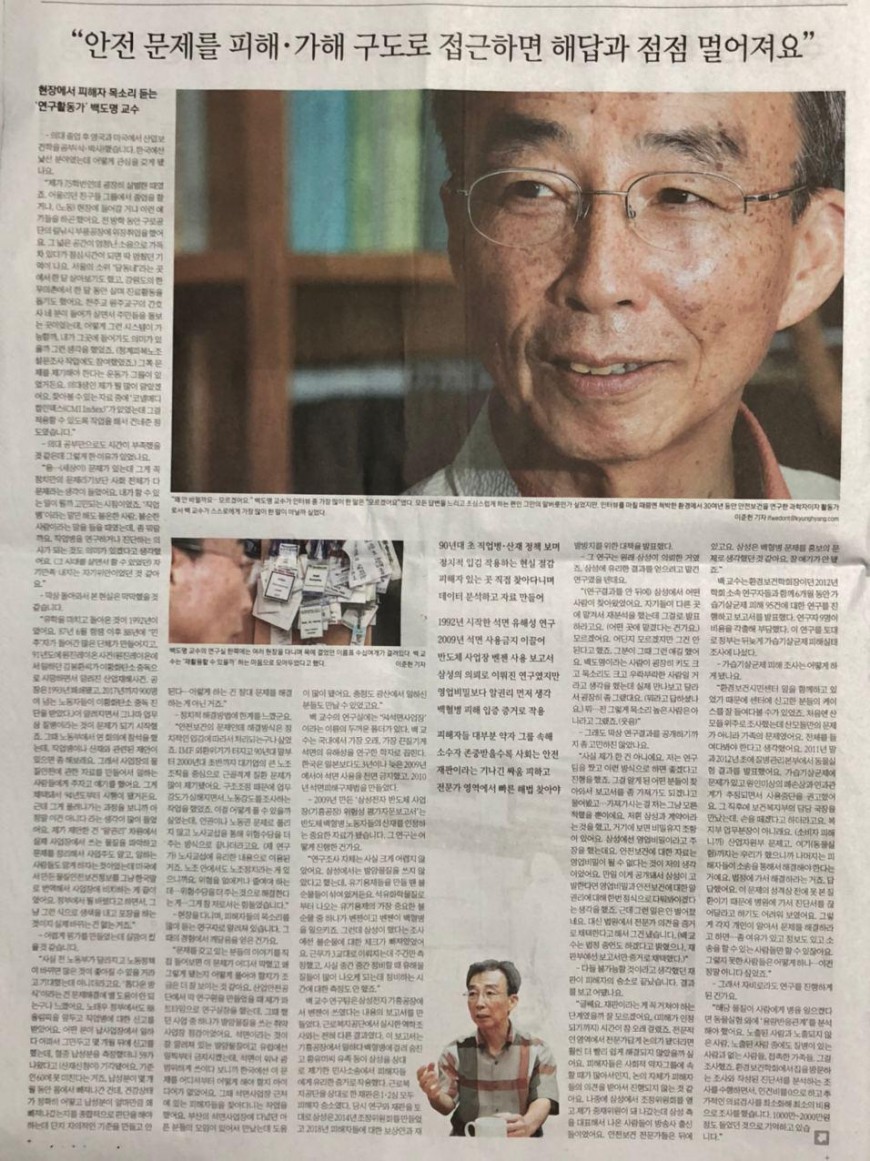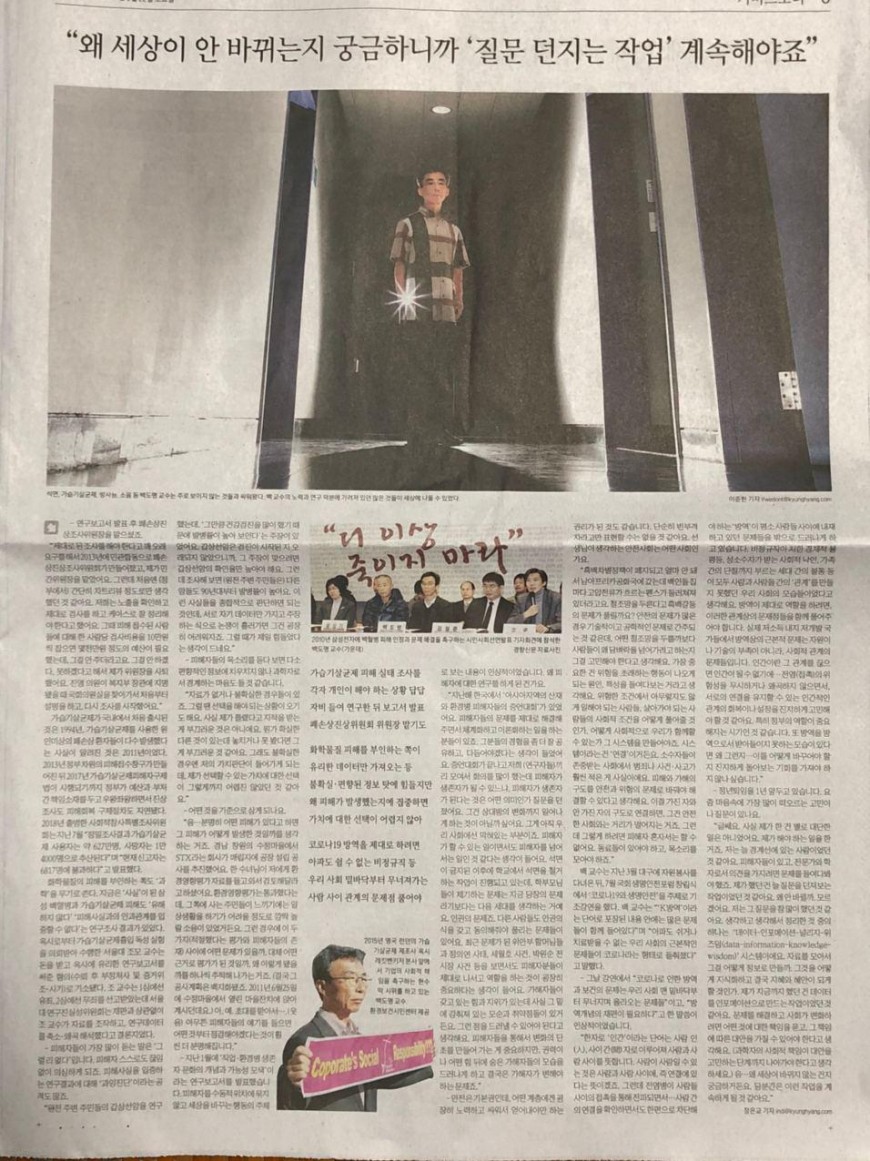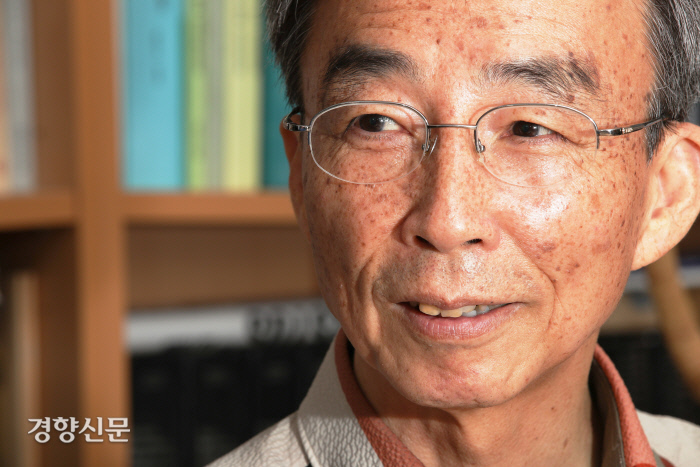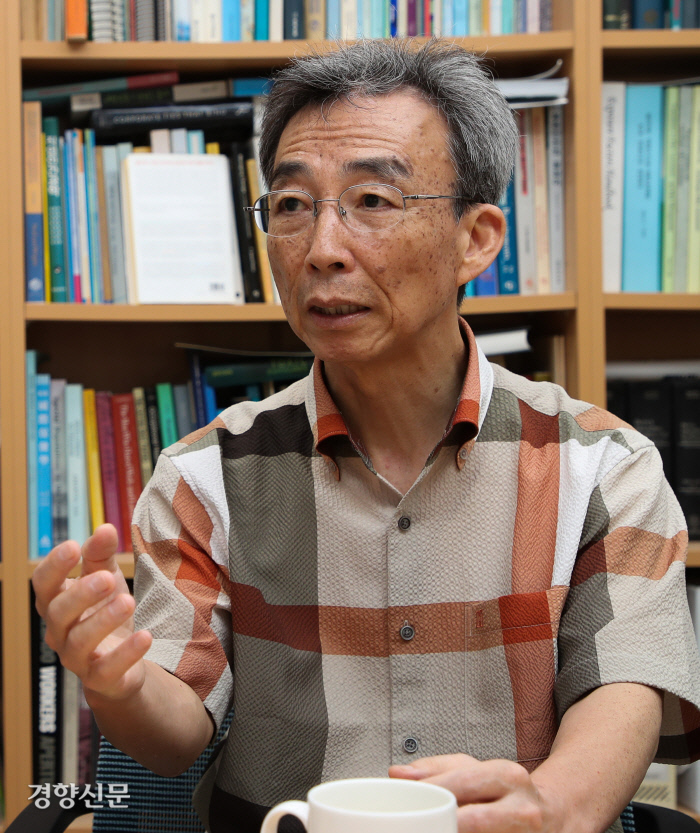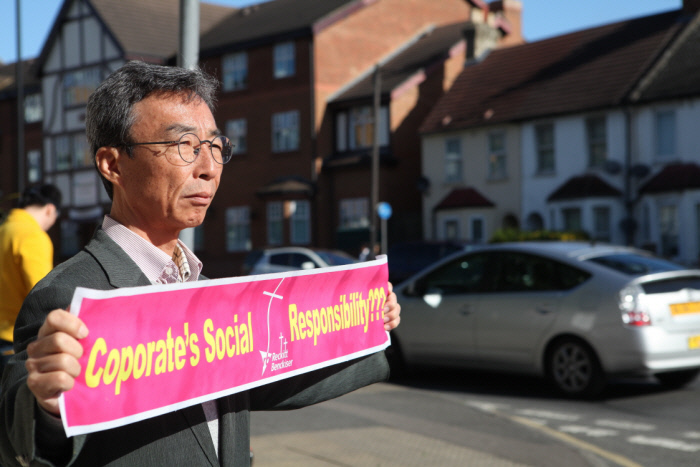[Cover Story]'Research Activist' Baek Do-myeong, stands beside the wea…
[Cover Story]'Research Activist' Baek Do-myeong, stands beside the weak under'the name of science'
“Why won’t it change… I do not know." Professor Domyung Baek said the most during his interviews was "I don't know." I thought it was his habit of speaking slowly and carefully in all answers, but at the end of the interview, I wondered if Professor Paik said the most to himself as a scientist and activist who studied safety and health for over 30 years in a barren environment. Reporter Lee Jun-heon
Effort is also required to get the name Damage to Damage. Some effort is too much to cover up with the word effort. Effort seems to be good to do, to do. However, some endeavors destroy everyday life and are only recognized as damage after the damage becomes more terrible. At first, so was the occupational diseases of semiconductor workers, which everyone now accepts as a fact, as well as damage from asbestos, humidifier disinfectants, and nuclear power plant radiation.
Do-myeong Baek, a doctor, scientist, and research activist, has been fighting'it can't happen'. You can't use asbestos? It can't be. You got leukemia from working in a semiconductor factory? It can't be. The lung damage is due to the humidifier disinfectant? It can't be. What Baek Do-myeong did from'can't' to'can' to'yes' was research. The facts of the damage were collected and the data were analyzed to create concrete evidence. Thanks to Baek Do-myeong's efforts and research, many have been able to become victims rather than those who complain or claim damage.
As a professor at Seoul National University (president of the Graduate School of Health), he is still active in research after a year before retirement. In July, it analyzed the data of 125 radon bed users diagnosed with cancer from 2013 to 2017 and announced the results of the'Radon Bed Health Impact Survey'. When Corona 19 spread in Daegu in March, I went to volunteer. In January, he published a research report entitled'Exploring the concept and possibility of a culture for survivors of occupational and environmental diseases', which studies victims of industrial accidents, sexual violence, and hazardous chemicals. He isn't just in the lab. It is not difficult to find him at a press conference or one-person protest. He attended both radon bed victims' press conferences and grabbed the microphone. In 2015, a demonstration was held in the UK, where Oxy, a maker of humidifier disinfectants, is located. This is because they believe that it is the responsibility of the scientist to prove the facts of damage, inform them, and further change society. On the 13th, I met Professor Paik in the lab of Seoul National University and heard about the'safety society' he thinks.
■Professor Domyeong Baek “When you approach the composition of avoiding and injuring safety issues, you get farther away from the answer.”
Professor Domyung Baek, a'research activist' who listens to victims' voices in the field
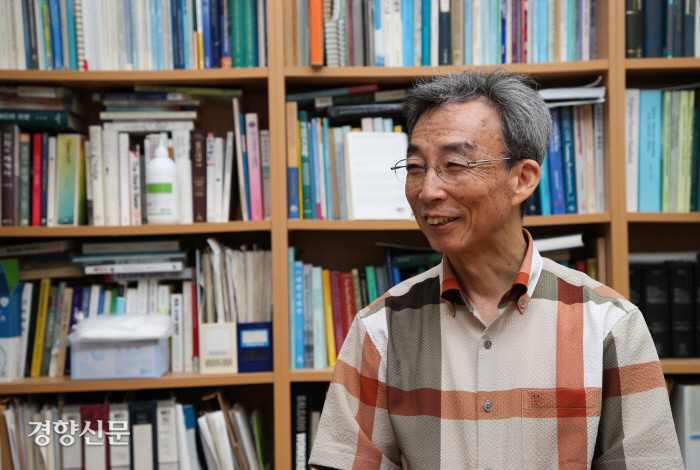
Professor Domyung Baek met at the Graduate School of Public Health at Seoul National University, Gwanak-gu, Seoul. / Reporter Lee Jun-heon
Early 90s watching occupational diseases, industrial accidents policy
realities and political action to reduce breath
traveled directly to find where the victims of
data analysis and data created
-After graduating from medical school, I studied occupational health (Master's and Doctorate) in the UK and the US. It was a strange field in Korea, but how did you become interested in it?
“I was in the 75th grade and it was a very bloody time. I used to talk about whether I was going to graduate from a group of friends I used to hang out with, or would I enter the (labor) field? During my vacation, I worked undercover at a reel fishing parts factory in Guro Industrial Complex. I remember that the large space was filled with tremendous noise and then stopped at lunchtime. I lived in a place called'Daldongne' in Seoul for a month, and I also lived in a muui village in Gangwon-do for a month and helped with medical treatment. It was a place where four nurses from the Catholic Diocese of Wonju live in and take care of the residents. (I was also involved in a survey of the Cheonggye clothing union.) There was a group of activists who said they should raise their issues. As a medical student, what would I have known a lot. Among the materials that can be found, there was'Cornel Medical Index', and I worked on it and handed it over to apply it.”
-I guess I didn't have enough time just by studying medical school, but was there a reason for doing so?
"Well… (Sesang) There was a problem, but I thought that it wasn't just a problem of politics, but rather that the whole society was a problem. It was a time when I was wondering what I could do. It was a time when I heard that the word'occupational disease' was an unclean person or an impure person. I thought it would be meaningful to be a doctor who studies or diagnoses occupational diseases. I think it was self-satisfaction or self-comfort (which I was able to do while living in those times).”
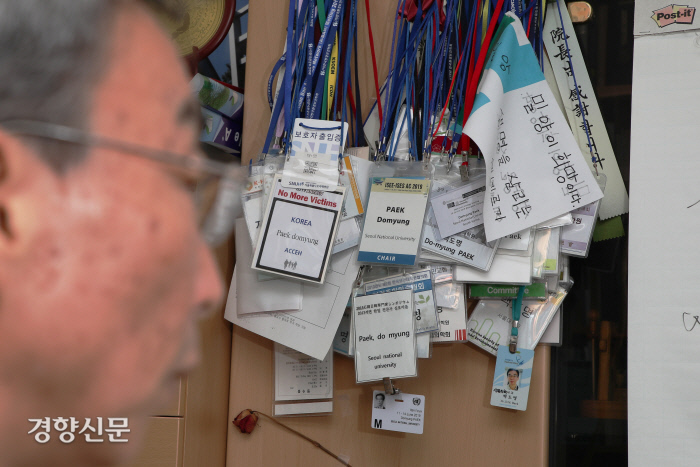
In one side of Professor Domyeong Baek's laboratory, dozens of name tags hung around his neck are hung from various sites. Professor Paik said that he collected it with the mind of'Can it be recycled?' Reporter Lee Jun-heon
Asbestos hazard research started in 1992
Leading the ban on the use of asbestos in 2009
Report on the use of benzene at semiconductor sites This
was a study commissioned by Samsung, but
thought the right to know before trade secrets Acted
as evidence to prove the damage to leukemia
-The reality I saw when I came back seems to have been daunting.
“I came back after studying abroad in 1992. After the uprising in June 1987, a number of groups with'democrats' were formed in 1988, and the Wonjin Rayon case in 1991 (an industrial accident known as Kim Bong-hwan, who worked at Wonjin Rayon, died of carbon disulfide poisoning. The factory was closed in 1993. By 2017, more than 900 workers had been diagnosed with carbon disulfide poisoning.) At that time, I attended a conference from the Ministry of Labor, and if you have any suggestions related to occupational diseases or industrial accidents, please do. So, I asked to make data on material safety at work and give it to the people who work. It was adopted and it has been implemented since 1994. But when I saw the process of being solved, I thought a lot that this is not really it. In terms of'right to know', what I suggested was to understand the substances used in the actual workplace and organize the problems so that the owners know and the people who work also know the material safety and health information created in the United States in Korean. It was over. They say something changed by the government, they just contemplate and wrap things that way, nothing really changes.”
-I made something difficult, but I think I was disappointed.
“In fact, I was hoping that if the Ministry of Labor changes and the labor policy changes, many things could improve, but it wasn't. I felt that the'top-down method' was not very helpful in solving the problem. The Roh Tae-woo administration also received reports of occupational diseases ahead of the 88 Olympics. Someone quit working at a lead factory because of pain and filed a report a few months later, but when the lead content in the blood was measured, 59 was found (industrial accident claim) was dismissed. It doesn't meet the standard 60. The lead component has been withdrawn from the body for several months, and it is necessary to comprehensively judge how exactly the state of health is and how much and why the lead component has been removed, but it is not possible to make an arbitrary standard... Doing this is never going to solve the problem.”
-You felt limited in the political solution.
“It is a safety and health problem, but I thought that the solution was handled according to political breath. After the IMF financial crisis broke out, many issues of musculoskeletal disorders were raised mainly from large union organizations of large companies from the late 90s to the early 2000s. As the work intensity intensified because of the restructuring, I worked to investigate the intensity of labor. I was wondering how to solve this, but it was not solved due to human rights or labor rights issues, but it ended in a way that increased risk allowances through labor-management negotiations. (My researcher) It was used as an advantage for labor-management negotiations. There is also a labor union within the union. I have to eliminate or reduce the risk... To solve it by giving more risk allowance... That was really difficult for me.”
-It is known as a researcher who goes to the field and listens to the voices of victims a lot. Did you gain enlightenment from the experience at that time?
“If I listen to the stories of people who have problems, it seems a little better to see where this problem was blocked, why it happened, and how to solve it. When I just started a researcher at the Occupational Safety & Health Agency, I was part-time as the head of the research department, and one of the projects I did at that time was the inspection of vulnerable workplaces using carcinogens. Asbestos is a well-known carcinogen, and it was banned early in Europe, but since asbestos is so widely used, there was no idea where to do this in Korea. At that time, I worked to find victims near the asbestos business. There was a meeting of sick people who went to the asbestos business site in Busan, so I met them and it was very helpful. I could also meet people who worked at the mines in Chungcheong Province.”
In Professor Paik's laboratory, there is a thick folder named '94 Asbestos Workplace'. Professor Paik is regarded as the longest and most persistent scholar who has studied the harmfulness of asbestos in Korea. Korea completely banned the use of asbestos in 2009, three years later than Japan, and established the Asbestos Damage Relief Act in 2010.
-The'Samsung Electronics Semiconductor Plant (Giheung Plant) Risk Assessment Advisory Report' made in 2009 has become an important data for acknowledging industrial accidents of semiconductor leukemia workers. How did you do that research?
“The research itself was not really difficult. Samsung said it did not use carcinogens, but when making organic solvents, impurities are mixed. One of the most important impurities in organic solvents from petrochemicals is benzene, and benzene causes leukemia. However, in the investigation that Samsung did, the check for impurities was omitted. The work takes place in three shifts, and I measured only weekly, and in fact, there are a lot of toxic substances coming out during maintenance in the middle, but I did not measure the maintenance time.”
Professor Paik's research team made a report stating that benzene was used at Samsung Electronics' Giheung plant. The result was completely different from the epidemiological investigation conducted by the Korea Labor Welfare Corporation. This report served as evidence in favor of victims in a civil lawsuit filed against Samsung by the late Hwang Yoo-mi, who died of leukemia while working at the Giheung plant. In the trial against the Korea Labor Welfare Corporation, both the first and second trials won the victims. Based on the research and trial at the time, Samsung created a mediation committee in 2014, and in 2018 announced compensation plans for victims and measures to prevent recurrence.
-The research was originally commissioned by Samsung. It must have been a study entrusted to Samsung to achieve favorable results.
“(After knowing the research results) someone came from Samsung. They left it to another place and reanalyzed it, and they told me to announce it. (Where did you leave it?) I don't know. I don't know where it is, but I said no. He said that at that time. I thought that a person named Baek Do-myeong would be a very tall, loud, loud person, but he was a little bit different because he was different from meeting him. (What did you say?) Well... I said that I'm not a very vocal person (laughs)”
-Still, haven't you been worried about the research results?
“Actually, I didn't do it. I formed a research team and proceeded to say that it would be nice to do it this way. Some people who learned about it came to me and asked if I could take some reports... I just pretended not to know you were taking it. We made a contract with Samsung, and there is a confidentiality clause there. Samsung claimed it was a trade secret. It was my idea that data on safety and health cannot be a trade secret. I thought that if this was disclosed and Samsung accused it, I would have to formally argue about the right to know trade secrets and safety and health. But that didn't happen. Instead, they did it because the court adopted expert opinion as evidence. (Professor Paik said he would testify in court, but the court adopted only the report as evidence.)
Most of the victims belong to the underprivileged group, and the
more respected the minorities are, the more society should
avoid the long fight of safety trials and
find a quick solution in the field of experts.
-The trial that everyone thought would be impossible ended with the victim's victory. How was it after seeing the result.
"I do not know. I'm not sure if the trial was a step I had to go through. It took a long time (until the damage was recognized). If it had been discussed like an expert in the professional field, it would have been easier to solve much faster. The victims often belong to the underprivileged group, so it seems that the discussion itself does not proceed with the victims' opinions. Later, Samsung held a mediation committee and I became a mediator, and the people who came out on behalf of Samsung were from broadcasting companies. Safety and health experts are behind. I think Samsung considered the leukemia issue as a public relations issue. I didn't talk well.”
In 2012, Professor Paik, who was the president of the Environmental Health Association, conducted a study on 95 cases of humidifier disinfectant damage and published a report with researchers from the society. Nine researchers paid for it. Based on this study, the government belatedly investigated the damage of humidifier disinfectants.
-How did you investigate the humidifier disinfectant damage?
“Because I was working with the Environmental Health Citizen Center, I was able to look closely at the cases of those who reported to the center. At first, we focused on mothers, but it wasn't just a mothers problem, it was a family problem. I thought I had to look into the whole. In late 2011 and early 2012, the Korea Centers for Disease Control and Prevention announced the results of animal experiments. As there was a problem with the humidifier disinfectant and a cause-and-effect relationship with lung damage of unknown cause was estimated, discontinuation of use was recommended. Immediately after that, I met the director in charge of the Ministry of Health and Welfare, and he said he would remove his hand. It's not a division of work from the Ministry of Welfare. (Because it is consumer damage) It is a problem of the Ministry of Commerce, Industry and Energy, and since we did this (animal experiment), the rest is that the victims have to solve it through lawsuits. It means to go to court and settle it. It was frustrating. Due to the nature of this problem, it seemed difficult to go to the hospital and ask for a medical certificate because it is a disease that I have not seen before. If you ask each individual to solve the problem on their own... Only those who can afford it, have information, and can sue can do it. What about those who can't... I really didn't want this to happen.”
-So, did you start researching at your own expense?
“If the substance caused illness in humans, the'dose response relationship' had to be analyzed in addition to animal testing. Those who are exposed and who are not exposed, those who have or are not exposed to the disease, and family members who have been in contact. I investigated it. The Environmental Health Association conducted a home visit survey and a survey to analyze the written medical certificate, while the labor cost was set to zero and additional medical tests were minimized, and the survey was conducted at minimal cost. I remember that it cost about 10 to 20 million won.”
■“I’m curious about why the world doesn’t change, so I have to keep asking questions.”
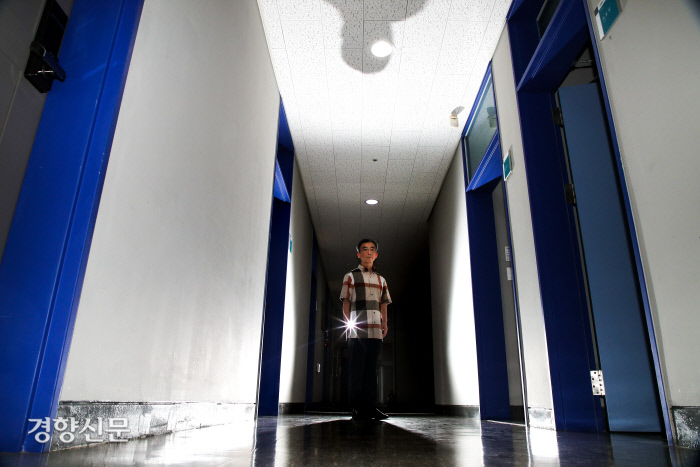
Asbestos, humidifier disinfectant, radioactivity, noise, etc. Professor Domyung Baek has been fighting mainly invisible things. Thanks to Professor Paik's efforts and research, many things that were hidden were able to come into the world. Reporter Lee Jun-heon ifwedont@kyunghyang.com
A humidifier disinfectants damage survey
each situation must be frustrating for the individuals
released after researching let mercy Report
Lung Injury Fact Committee matgido
-After publishing the research report, you served as the chairman of the lung injury investigation committee.
“I asked for a long time to do a proper investigation, so in 2013, a joint public-private investigation committee was formed, and I was the chairman of the private committee. But at first (the government) thought it was only a simple chart review. We said that we should check the exposure, inspect it properly, and organize it into cases. At that time, if the cost of inspection per person for the victims was 100,000 won, a budget of about tens of millions of won was needed, but I didn't give it. I resigned as the chairman because I said I couldn't or couldn't. When Congressman Jin Young was nominated as the Minister of Welfare, I went to the office of the National Assembly and explained it from the beginning, and started the investigation again.”
Humidifier disinfectant was first released in Korea in 1994, and it was known in 2011 that many patients with unknown cause of lung injury using humidifier disinfectant occurred. After the government-level damage reception counter was established in 2013, until the Humidifier Sterilization Disinfectant Relief Act was implemented in 2017. The Special Investigation Committee for Social Disasters, which was launched in 2018, announced in July, "As a result of a detailed investigation, the number of humidifier disinfectant users is estimated to be about 6.27 million and the death toll is 14,000."

Prof. Domyung Baek (center) attended a press conference for the announcement of the Civil Society Declaration urging Samsung Electronics to acknowledge the leukemia damage and solve the problem in 2010. Kyunghyang Newspaper material photo
It is difficult to deny chemical damage due to uncertain and biased information
such as bringing only favorable data
, but
if you focus on why the damage occurred, it is not difficult to choose the
value.
Those who deny the damage of chemicals also use'science' as a weapon. Research results showed that Samsung's leukemia and humidifier disinfectant damage, which has become a'fact', is'not harmful' and'cannot prove a causal relationship with the facts of the damage'. Professor Jomo of Seoul National University, who was commissioned by Oxy to conduct a humidifier disinfectant inhalation toxicity experiment, was charged with writing a research report favorable to Oxy (after commissioning, fraudulent treatment and forgery of evidence). Professor Cho was convicted in the first trial and not guilty in the second trial, but the Research Integrity Committee at Seoul National University concluded that Professor Cho manipulated the data and interpreted the reduced and distorted research data regardless of the trial.
-The word that victims hear the most is'it can't happen'. Even the victims themselves become constantly suspicious. There are many attacks called'overdiagnosis' against research results that prove the fact of damage.
“I studied thyroid cancer in residents around the nuclear power plant, and there was a claim that'the incidence seems to be high because of that much health checkups'. Thyroid cancer screenings haven't been around for a long time, so for that claim to be true, only the confirmation rate of thyroid cancer has to be high. However, if you look at it, other cancers (residents around the nuclear power plant) also have a high incidence from the 1990s. All you have to do is to judge these facts comprehensively, but it becomes very difficult if the debate flows in such a way that they argue with only their own data. I think that was the hardest time.”
-Listening to the voices of the victims seems to be wary as a scientist.
“There are cases where there is no data or uncertainty. In that case, you may have to make a choice. In fact, I am not ashamed to be criticized for being wrong. If there's something else that's obvious and you missed it or didn't see it, that's a shame. Still, in case of uncertainty, my judgment of value goes into it, but I don't think the choice of the value I can choose was so difficult.”
-What will be the standard?
"Well… Obviously, if there is any damage, you are thinking about how the damage occurred. In Sujeong Village in Changwon, Gyeongnam, a company called STX promoted the construction of a factory in a landfill. A nun asked me to come and review the environmental impact assessment data. The environmental impact assessment passed, but there was a surprising noise that made it difficult for the residents living there to feel it. In such a case, what is the problem between these two (appropriate evaluation and the existence of the victims), on what basis the evaluation was made, and why this happened, one by one, we trace. (Eventually, the construction plan was blank. He was sitting at a village feast held in Sujeong Village on June 25, 2011.) Oh, yes. I was invited... .(Laughter) Anyway, when I hear the victims, it becomes much clearer that I have to check things first.”
-In January, we published a research report titled'Exploring the concept and possibility of a culture for survivors of occupational and environmental diseases'. It was impressive to see the victim as a subject of action that changes the world without being tied to a passive position. Why did you do research on the victims?



